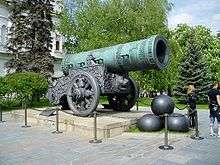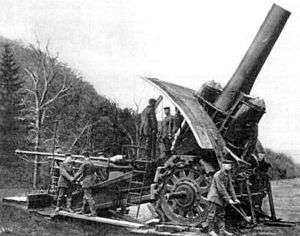Supergun
A supergun is an extraordinarily large artillery piece. This size may be due to a large bore, barrel length, or a combination of the two. While early examples tended to have a fairly short range, more recent examples have sometimes had an extremely high muzzle velocity, resulting in a very long range.
Depending on the design, they may be used to destroy heavy fortifications or bombard an enemy from extremely long range.
Gunpowder age

In the context of late medieval siege warfare the term superguns is sometimes applied to stone-firing bombards with a ball diameter of more than 50 cm.[1] These superguns were either manufactured by forging together longitudinal iron bars, held in place by iron rings, or cast in bronze with techniques generally similar to bellfounding.[2] Known examples include the Pumhart von Steyr, Dulle Griet and Mons Meg (all iron) as well as the cast-bronze Faule Mette, Faule Grete and Dardanelles Gun.

At the beginning of the development of superguns was the desire to increase the effect of the projectiles. To this end, master gunners first simply used larger powder loads. These, however, exerted larger pressure on the existing cannon and could make it burst, causing the death of the irreplaceable gunner with his crew (and even kings). In addition, it was observed that, due to their higher velocity, stone balls were shattered by the impact on the walls rather than smashing them. Thus, the mass of the cannonballs and, consequently, of the ordnance, also, continually increased, culminating in giant cannon like the Pumhart von Steyr which fired a 690 kg ball. Apart from the anticipated improvement in penetrating power, other factors such as prestige and a potential deterrent effect also played an important role.[4]

For all their manufacturing quality the superguns were only moderately successful. Their military effectiveness turned out to be disproportionate to their overwhelming logistical demands and financial costs. For the cost of a single supergun, two or three large bombards with a reasonably smaller caliber (in German Hauptbüchse) could be produced whose firepower was enough to shatter any medieval wall, in particular when it was concentrated in a battery. Due to their less bulky dimensions and higher rate of fire, these artillery pieces could be more flexibly deployed and caused more destruction in any given length of time. Furthermore, the transition from stone to smaller, but much more devastating iron balls meant that super-sized bores became unnecessary.[5] The caliber of a 50 pound ball, for example, could be reduced from 28 to 18 cm when using an iron projectile instead.[6]
Thus, as early as the second half of the 15th century, further development in siege technology concentrated on the Hauptbüchse,[7] and bombards largely disappeared from the leading artillery arsenal of the dukes of Burgundy.[8]
At about the same time super-sized bombards were phased out in Western Europe, the technology was transmitted to the Ottoman army by Orban, a Hungarian gunfounder, on the occasion of the Siege of Constantinople in 1453.[9] The extant Dardanelles Gun, cast by the Ottoman gunfounder Ali several years later, is assumed to have followed closely the outline of Orban's guns.[9] A similar super-sized bombard was employed by the Ottoman navy aboard a carrack of possibly Venetian design at the Battle of Zonchio in 1499.[10]
In India, a large forge-welded iron cannon was built during the reign of Raghunatha Nayak (1600-1645), and was then one of the largest cannons in the world. Artillery was used by Indian armies predominantly for defending against besieging armies.[11]
Modern superguns
With the new metallurgical methods and precision engineering of the Industrial Revolution, a revolution in armaments, including artillery took place. In the 1860s, the industrialist Sir William Armstrong, who had already built one of the first breech-loading rifled artillery pieces, constructed a 600-pounder 'monster gun' of then extraordinary size at the Elswick Ordnance Company in Newcastle. The gun was a rifled muzzle-loader of 22 tons that fired shells of up to 600 pounds (270 kg) and could pierce 4.5 inches (11.4 cm) of iron armour. Armstrong identified them as "shunt" guns, but they were soon popularly known as "monster" guns.[12]
By the 1880s he had built guns of over 40 feet (12m) in length that could fire 1,800 pound (810 kg) shells and punch through an incredible 30 inches (76 cm) of iron at a range of 8 miles. The gun was exhibited at the Royal Mining, Engineering and Industrial Exhibition held at Newcastle in 1887 for Queen Victoria's golden jubilee.[13]

Prior to World War I, the German military was especially interested in the development of superweapons due to the need for the Schlieffen plan to march past a line of Belgian fortifications constructed specifically to stop such an invasion route. During the opening phases of the war, the Germans employed a 420 mm Krupp howitzer (the Big Bertha) and two 305 mm Skoda Mörser M. 11 mortars to reduce the famous fortresses of Liège and Namur. Their low overland mobility made them arrive later than the infantry at Liège, so several infantry assaults were made with heavy loss of life and generally little success. The guns arrived a few days later and reduced the forts at Liège one-by-one over a short period of a few days.
Larger artillery after this opening period was generally limited to railway guns, which had much greater mobility, or naval monitors (two of the British Lord Clive class monitors were fitted with an 18 inch (457 mm) gun, and HMS General Wolfe fired 33 km (21 mi) at a railway bridge in Belgium). All of the major powers involved employed such weapons in limited numbers, typically between 280 and 305 mm (11 to 12 inches) although some larger weapons were also used. The largest of the railway guns deployed in World War I was the Paris Gun, which was used to bombard Paris from a distance of over 130 kilometres (81 mi).

Development continued during the inter-war era, although at a more limited pace as aircraft were expected to take over in the long-range bombardment role. Nevertheless, the Germans built a handful of powerful Krupp K5s and the great 800 mm (31.5 in.) Schwerer Gustav and Dora. The latter had been designed specifically to defeat the Maginot Line, firing a 7-ton shell to a range of 37 km (23 mi). Although their original role proved unnecessary, Gustav was used successfully to demolish several heavy fortifications, most notably those at Sevastopol. Dora was readied for combat at Stalingrad, but was withdrawn before it could be used. Gustav and Dora were the largest artillery pieces (by caliber) ever used in combat. Development may have ended there but for the ever-increasing Allied air power, which limited Hitler's options in terms of re-opening bombing attacks on London. This led to the development of the V-3 "London Gun" or "Hochdruckpumpe", fired from Mimoyecques in the Pas de Calais, about 95 miles (153 km) away. Two attempts to build underground bunkers for the huge weapons were thwarted by massive Royal Air Force bombing raids, which made further attempts futile. Two smaller prototype versions of the gun were used during the Battle of the Bulge.
Recent developments
Canadian-born engineer Gerald Bull later became interested in the possibility of using superguns in place of rockets to insert payloads into orbit. He started Project HARP to investigate this concept. HARP was later cancelled, and Bull turned to military designs, eventually developing the GC-45 howitzer. Some years later, Bull interested Saddam Hussein in funding Project Babylon. The objective of this project is not certain, but it is thought to have been intended to develop a gun capable of firing an object into orbit, from where it could then drop onto any place on the Earth. Gerald Bull was assassinated, terminating development, and the parts were confiscated by British customs after the Gulf War.
A publication in May 2014 suggested the US Navy had developed a supergun (actually a prototype railgun, known as the Electro-Magnetic Laboratory Rail Gun), capable of shooting shells at 5600 MPH (7 times the speed of sound). [14]
See also
- Railgun
- Bombard (weapon)
- List of artillery
- List of the largest cannon by caliber
- Paris Gun
- Super High Altitude Research Project
- Coriolis effect
- The Guns of Navarone (novel): A 1957 action/adventure novel by Alistair Maclean about two fictional German superguns and the mission set out to destroy them during WWII.
- The Guns of Navarone (film): A 1961 film by J. Lee Thompson based on the book of the same name.
Footnotes
- ↑ Schmidtchen 1977a, p. 153
- ↑ Schmidtchen 1977a, p. 157
- ↑ Schmidtchen 1977a, p. 162
- ↑ Schmidtchen 1977b, pp. 228–230
- ↑ Schmidtchen 1977b, pp. 229–230
- ↑ Eschelbach 1972, p. 276
- ↑ Schmidtchen 1977b, p. 230
- ↑ Smith & DeVries 2005, p. 205
- 1 2 Schmidtchen (1977b), p. 226
- ↑ John F. Guilmartin, Jr. (2007), "The Earliest Shipboard Gunpowder Ordnance: An Analysis of Its Technical Parameters and Tactical Capabilities", Journal of Military History 71 (3): 649–669 [659], doi:10.1353/jmh.2007.0204
- ↑ R. Balasubramaniam, A. Saxena, Tanjore R. Anantharaman, S. Reguer, P. Dillmann. "A Marvel of Medieval Indian Metallurgy: Thanjavur’s Forge-Welded Iron Cannon" (PDF).
- ↑ Marshall J. Bastable. "From Breechloaders to Monster Guns: Sir William Armstrong and the Invention of Modern Artillery, 1854-1880". JSTOR. Retrieved December 1, 2013.
- ↑ "Armstrong's 'monster' gun revealed".
- ↑ "Electromagnetic Railgun - Office of Naval Research". www.onr.navy.mil. Retrieved 2015-10-08.
References
- Eschelbach, Rudolf (1972), "Das Feuergeschütz des Mittelalters (1350–1550)", Technikgeschichte 39 (4): 257–279
- Schmidtchen, Volker (1977a), "Riesengeschütze des 15. Jahrhunderts. Technische Höchstleistungen ihrer Zeit", Technikgeschichte 44 (2): 153–173
- Schmidtchen, Volker (1977b), "Riesengeschütze des 15. Jahrhunderts. Technische Höchstleistungen ihrer Zeit", Technikgeschichte 44 (3): 213–237
- Smith, Robert Douglas; DeVries, Kelly (2005), The artillery of the Dukes of Burgundy, 1363-1477, Boydell Press, ISBN 978-1-84383-162-4
Further reading
- Gerald V. Bull, Charles H. Murphy, Paris Kanonen: The Paris Guns (Wilhelmgeschutze) and Project HARP, E. S. Mittler, Herford, 1988
| ||||||||||||||||||||||||||||||